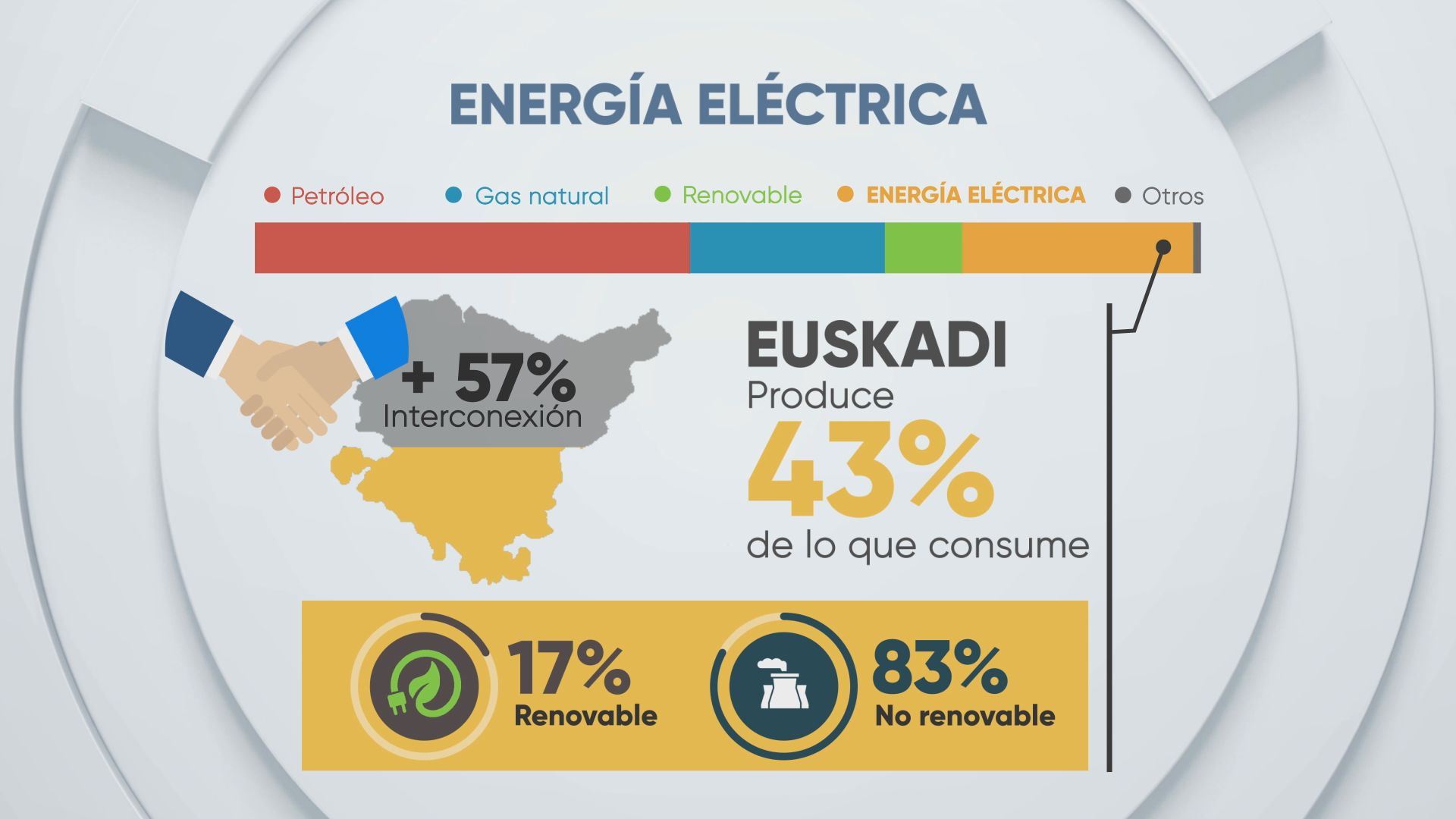In addition, the energy bill in Euskadi is 930 euros per person per year and is expected to exceed 1,000 euros this year. Likewise, the energy bill represents 6-7% of the expenditure of Basque households.
Euskaraz irakurri: EITB DATA: Euskadin soilik ekoizten dugu kontsumitzen dugun energiaren % 10
The self-sufficiency rate in Euskadi does not reach 10%, that is, we have to buy 90% of the energy we consumeand we need to do it both in the state and in other countries, according to data from EUSTAT and the Basque Energy Agency (EVE).
This follows from the previous EITB DATA study conducted on the energy sectorand which today publishes EITB in all its media.
The direct consequence of self-sufficiency at levels not exceeding 10% (9.7) is the Basque Country’s heavy dependence on energy from abroad. This data is relatively stable since 2018, with a slight improvement, after being at a higher threshold in previous years.
Another aspect to emphasize is that the value of self-sufficiency is far from the European Union average of 27, which is 45.1%. Sweden appears to be the country with the least foreign dependence, with its own production of 70%, and Italy (23.7%) and Spain (27.2%) have low values, although significantly higher than in the Basque Country, according to up to and with 2019 data.
More than two thirds (45.8%) of the final energy we consume in the Basque Country is oil and derivatives, and gas. The data is comparable to that in other communities, but much higher than in other countries such as France, Germany and Italy, where the weight of oil and derivatives ranges between 34.4% and 38.7%.
EITBDATA
Euskadi produces 43% of the electricity it consumes; Navarre, 172%
In the case of electricity production specifically, Euskadi produces 43% electricity that it consumes, of which only 17% comes from renewable sources, therefore the origin of the remaining 83% is from non-renewable sources. 57% of the electricity it consumes comes from the Iberian interconnection system, that is, from other autonomous communities.

EITBDATA
In NavarraOn the other hand, 172% of the electricity it consumes is produced, 49% from renewable sources and 51% from non-renewable sources. The remaining 72% of the production is discharged to the interconnection system.
Spain also produces more than it consumes: 101%, of which 47% is from renewable sources and 53% is non-renewable.

EITBDATA
6-7% of the household bill is spent on paying for energy in the Basque Country
As for the expenditure of this energy in homes, it represents 6-7% of the total in Euskadi and 8-9% in the state. There is a small variability between communities, depending on the “wealth of households”, and it is this aspect that makes the percentage somewhat lower in the Basque Country, 6.4% (data from 2018-2019).

EITBDATA
Each person spends 930 euros per year on energy in the Basque Country
in Euskadi ceach person spends an average of 930 euros per year in energy, according to the average data from the years 2018 and 2019, years when there was no pandemic or war in Ukraine.
Of that energy bill, almost half of the total (47%) is spent on fuels (automotive), a third in electricity (31.4%), 18.3% in gas and 2.8% in others.
For this 2022, according to the growing price trend, it is possible that the energy bill will exceed 1,000 euros per person/year, surpassing all historical data.

EITBDATA
And precisely in proportion to the household energy bill, both electricity and gas bills have risen significantly in all communities.
In the case of electricity price, Spain is in second place in the EU-27, only behind Germany. Also in the ranking of gas prices, Spain is the second EU-27 country to pay more for this fuel, after Sweden, according to data published by EUROSTAT.
The reasons why electricity and gas are paid at such a high price are similar in both cases: the consumption price panel according to the type of consumer (households, industry) and the markets (regulated and free); the energy “mix” of each country and the ecological transition strategies.
24 months of abnormal behavior that explains the increase
In explaining the causes of the rise in energy prices, we have to look back 24 months, a time when “abnormal” behavior has been certified, according to the aforementioned EITB DATA study, with data sourced from the Ministry of Ecological Transition and Demographic Challenge.
-In 2020Due to the cessation of economic activity and consumption, the demand for energy shrank and prices fell.
-In 2021after the shutdown caused by the pandemic, the normalization of economic activity and consumption stimulated energy demand, and prices started to show their upward trend.
-As early as 2022, the Russian invasion of Ukraine caused an immediate rise in gas prices and immediately destabilized energy markets. It is precisely in the first months of the year that we have seen record highs in both gas and oil prices.
Exactly, the evolution of the price of Brent oil – reference price for fuels such as petrol, diesel, kerosene, etc. – follows the same trajectory as gas and electricity, albeit slightly more moderately.
(function(d, s, id) {
var js, fjs = d.getElementsByTagName(s)[0];
if (d.getElementById(id)) return;
js = d.createElement(s); js.id = id;
js.src = “//connect.facebook.net/es_ES/sdk.js#xfbml=1&version=v2.8”;
fjs.parentNode.insertBefore(js, fjs);
}(document, ‘script’, ‘facebook-jssdk’));
Source: EITB
I’m Wayne Wickman, a professional journalist and author for Today Times Live. My specialty is covering global news and current events, offering readers a unique perspective on the world’s most pressing issues. I’m passionate about storytelling and helping people stay informed on the goings-on of our planet.



